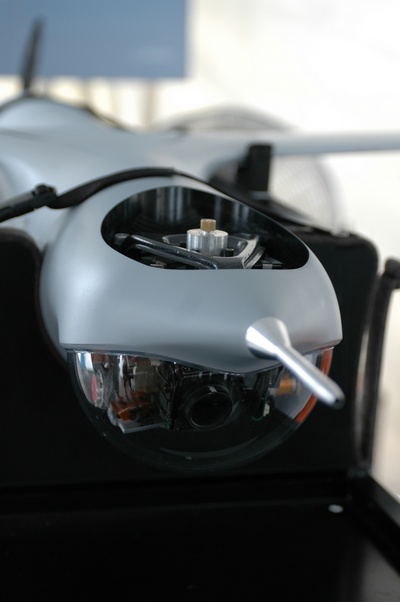Bowie, MD
Tuesday, May 05, 2009

EO/IR Sensors
First and foremost, an unmanned aircraft system (UAS) is an unblinking eye in the sky
While the technology in this Intelligence, Surveillance and Reconnaissance (ISR) platform is evolving rapidly, the mission still remains the same, providing the fullest possible understanding of the adversary to the commanding officer. The unmanned aerial vehicle (UAV) has the range and endurance to provide a bird's-eye view of the battlefield and is flexible enough for dynamic mission re-tasking. This allows timely receipt of information about the enemy, when and where it is needed, without having to risk a manned aircraft.
Large UAVs like the Predator and Global Hawk can access Class A airspace (above 18,000 ft). Their long endurance and virtually unlimited range makes them ideal platforms for surveillance operations. They are routinely controlled halfway around the world by pilot-rated US Air Force officers. Ku-band satellite links are used for these beyond line-of-sight (BLOS) operations.
Operational altitudes range for the smaller tactical UAVs like the Scan Eagle are typically from 2,000-5,000 feet but flights up to 8,000 feet (6,000 at night) are common. Line-of-sight (LOS) range is about 50-100 miles when the ground is flat, or even less when hilly or mountainous.
Electro-Optical/ Infrared (EO/IR) cameras are carried on many UAVs and work best at acquiring good imagery when operating at low altitudes. This is due to several factors including:
• a smaller amount of atmospheric haze,
• a smaller focal-length and
• smaller stabilization requirements
What affect does fog or low cloud ceilings have on the usefulness of these payloads?
Can IR cameras penetrate a fog bank?
How does fog change UAS operations?
Take-offs or Landings?
What about winds?
Icing conditions?
Or heavy rain?
To help you answer these questions and to help you make sense of the rapidly changing UAS industry, the Applied Technology Institute/ATIcourses.com of Riva, Md., is offering a new one-day course designed for engineers, aviation experts and project managers who wish to enhance their understanding in the growing field of UAS.
The course provides the "big picture" for those who work outside of the discipline. Each topic addresses real systems (Raven, Shadow, Predator, Global Hawk and others) and real-world problems and issues concerning the use and expansion of their applications.
UAS Course is on June 9th in Beltsville, MD.
Sign-up today!
While the technology in this Intelligence, Surveillance and Reconnaissance (ISR) platform is evolving rapidly, the mission still remains the same, providing the fullest possible understanding of the adversary to the commanding officer. The unmanned aerial vehicle (UAV) has the range and endurance to provide a bird's-eye view of the battlefield and is flexible enough for dynamic mission re-tasking. This allows timely receipt of information about the enemy, when and where it is needed, without having to risk a manned aircraft.
Large UAVs like the Predator and Global Hawk can access Class A airspace (above 18,000 ft). Their long endurance and virtually unlimited range makes them ideal platforms for surveillance operations. They are routinely controlled halfway around the world by pilot-rated US Air Force officers. Ku-band satellite links are used for these beyond line-of-sight (BLOS) operations.
Operational altitudes range for the smaller tactical UAVs like the Scan Eagle are typically from 2,000-5,000 feet but flights up to 8,000 feet (6,000 at night) are common. Line-of-sight (LOS) range is about 50-100 miles when the ground is flat, or even less when hilly or mountainous.
Electro-Optical/ Infrared (EO/IR) cameras are carried on many UAVs and work best at acquiring good imagery when operating at low altitudes. This is due to several factors including:
• a smaller amount of atmospheric haze,
• a smaller focal-length and
• smaller stabilization requirements
What affect does fog or low cloud ceilings have on the usefulness of these payloads?
Can IR cameras penetrate a fog bank?
How does fog change UAS operations?
Take-offs or Landings?
What about winds?
Icing conditions?
Or heavy rain?
To help you answer these questions and to help you make sense of the rapidly changing UAS industry, the Applied Technology Institute/ATIcourses.com of Riva, Md., is offering a new one-day course designed for engineers, aviation experts and project managers who wish to enhance their understanding in the growing field of UAS.
The course provides the "big picture" for those who work outside of the discipline. Each topic addresses real systems (Raven, Shadow, Predator, Global Hawk and others) and real-world problems and issues concerning the use and expansion of their applications.
UAS Course is on June 9th in Beltsville, MD.
Sign-up today!
Mark
UAS Instructor
ATI
Bowie, MD
240-882-1234
First Url: Sign-up for UAS Course
Second Url: Overview of UAS class
No comments:
Post a Comment